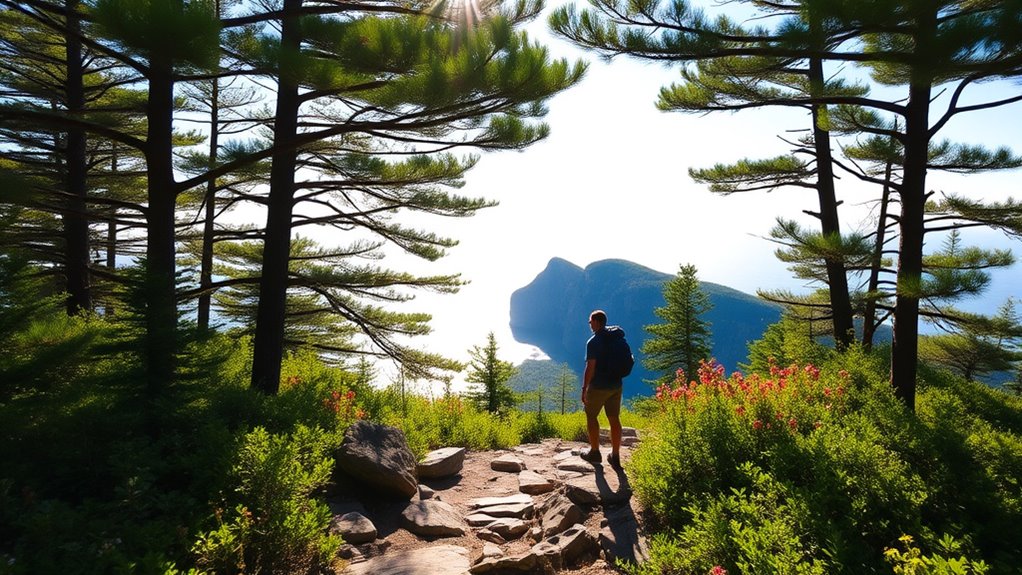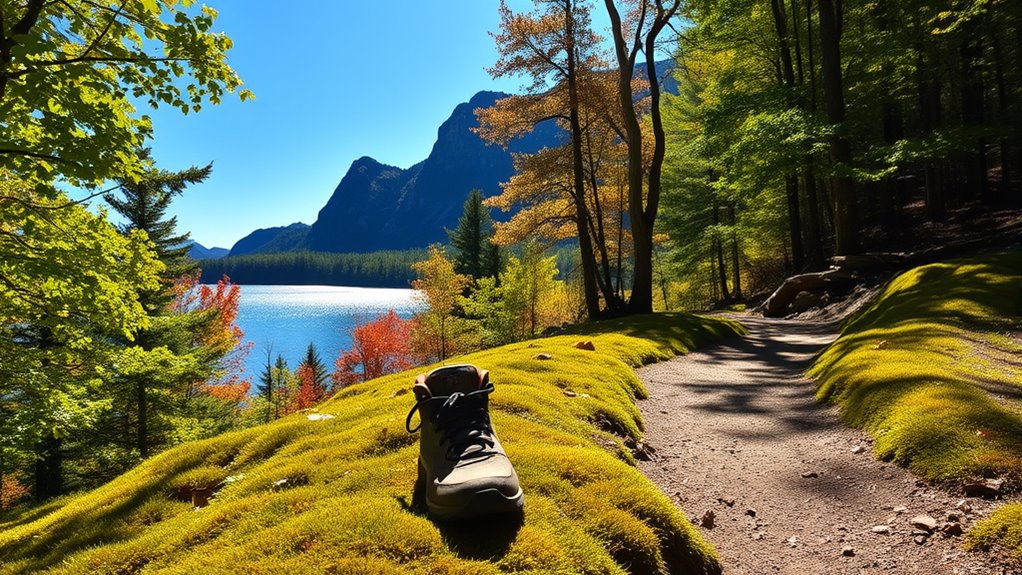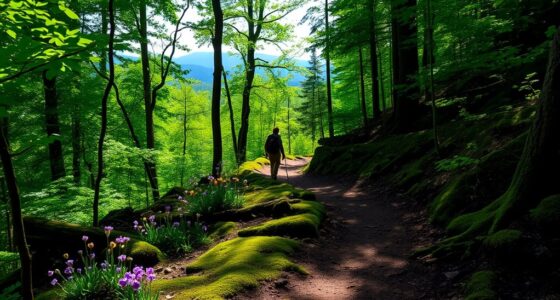Low-impact hiking in Acadia National Park lets you enjoy nature while protecting its unique ecosystem. Stay on designated trails to preserve habitats and minimize your impact. Always carry enough water and snacks, and be prepared for changing weather. Respect wildlife by keeping a safe distance, and remember to appreciate the sounds around you. Your choices can help maintain the park’s beauty for future visitors. Discover more tips to enhance your hiking experience in this stunning environment.
Key Takeaways
- Stay on designated trails to minimize habitat disturbance and protect native ecosystems while hiking in Acadia National Park.
- Carry out all trash and avoid leaving any waste to maintain the park’s natural beauty and cleanliness.
- Use established paths and avoid creating new trails to prevent soil erosion and habitat degradation.
- Practice Leave No Trace principles by minimizing your impact and respecting wildlife habitats during your hikes.
- Educate yourself about local wildlife and ecosystems to enhance your appreciation and understanding while hiking responsibly.

Acadia National Park boasts over 120 miles of hiking trails, making it a paradise for outdoor enthusiasts. As you lace up your boots and hit the trails, you’ll quickly realize that hiking here is more than just a walk in the woods; it’s about immersing yourself in a vibrant ecosystem. One of the joys of hiking in Acadia is the chance for wildlife encounters. From deer and foxes to a variety of bird species, you’ll likely spot some amazing creatures. However, you should always prioritize trail safety. Keeping a safe distance from wildlife not only protects you but also ensures the animals remain undisturbed in their natural habitat.
Hiking in Acadia National Park offers a unique chance to connect with nature and encounter diverse wildlife while prioritizing safety.
Before you set out, familiarize yourself with the park’s regulations regarding wildlife. It’s best to carry bear spray and know how to use it, especially if you’re venturing into more remote parts of the park. Remember, you’re a visitor in their home, and respecting their space is essential. This means staying on designated trails, which helps preserve the delicate habitats that sustain this wildlife. By sticking to the paths, you’re minimizing your impact and making your hike a low-impact adventure.
As you traverse the trails, keep an eye on the weather. Acadia’s conditions can change rapidly, and being prepared will enhance your experience and guarantee your safety. Bring layers, plenty of water, and snacks to keep your energy up. It’s a good idea to let someone know your plans before you head out. If you’re hiking solo, carry a map or download a trail app for easy navigation. Getting lost can lead to unnecessary stress, and your chances of wildlife encounters might diminish if you stray off course.
While hiking, take time to appreciate the surroundings. Listen to the rustling leaves and the distant calls of birds; nature has a way of recharging your spirit. If you’re lucky, you might catch a glimpse of a moose or a family of otters playing in the water. Remember, every step you take can either help or hinder the environment. By practicing low-impact hiking, you’re guaranteeing that future generations can enjoy the same beauty you do today. Additionally, remote work can provide the flexibility needed to plan your hikes during less crowded times.
In Acadia National Park, your experience is defined by your choices. By prioritizing wildlife encounters and trail safety, you’re contributing to the preservation of this stunning landscape while enjoying the adventure of a lifetime.
Frequently Asked Questions
Are Pets Allowed on Hiking Trails in Acadia National Park?
Yes, pets are allowed on some hiking trails in Acadia National Park, but there are pet restrictions you need to keep in mind. You’ll need to follow leash regulations, ensuring your pet stays on a leash no longer than six feet at all times. Remember, certain areas and trails may have additional restrictions, so it’s best to check the park’s guidelines before heading out with your furry friend. Enjoy your hike!
What Should I Wear for Low-Impact Hiking in Acadia?
For low-impact hiking, you’ll want to wear proper footwear, like sturdy hiking boots or shoes with good grip. Lightweight clothing is essential, too; choose moisture-wicking fabrics that keep you cool and dry. Layer your outfit to adjust for changing temperatures, and don’t forget a hat and sunglasses for sun protection. Staying comfortable will help you enjoy your hike and keep your energy up throughout the day. Happy hiking!
Are There Accessible Hiking Trails for Individuals With Disabilities?
Yes, there are accessible hiking trails for individuals with disabilities. You can find adaptive trails designed to accommodate various mobility needs, including those that are wheelchair accessible. These trails often feature smooth surfaces and gentle inclines, guaranteeing a comfortable experience. Before heading out, check local resources for trail conditions and accessibility details to make certain you have the best experience while enjoying nature. Enjoy your adventure and appreciate the beautiful scenery!
What Is the Best Time of Year for Low-Impact Hiking?
The best time for low-impact hiking feels like walking through a vivid painting, where seasonal weather dances with your senses. Spring and fall are ideal, as temperatures are mild, and trails are often dry and well-maintained. In spring, wildflowers bloom, while autumn brings a stunning tapestry of colors. Just watch for rain in spring or mud in fall; these can affect trail conditions. Embrace these seasons and enjoy nature’s beauty!
How Can I Find Guided Low-Impact Hiking Tours in Acadia?
You can find guided low-impact hiking tours in Acadia by searching online for local eco-friendly options. Websites like AllTrails or local outdoor shops often list guided tours that focus on sustainability. You might also check with the park’s visitor center for recommendations. Don’t hesitate to ask about their eco-friendly practices, ensuring your hike supports conservation efforts while you explore the beautiful trails in the area. Enjoy your adventure!
Conclusion
As you wrap up your low-impact hiking adventure in Acadia National Park, you might just stumble upon a hidden viewpoint where the sunset paints the sky in hues of orange and pink. Coincidentally, it’s the same spot where a family shared stories of their own hiking memories years ago. This moment, a blend of nature and nostalgia, reminds you that every step taken here is part of a larger journey—one that connects us all through the beauty of the great outdoors.










